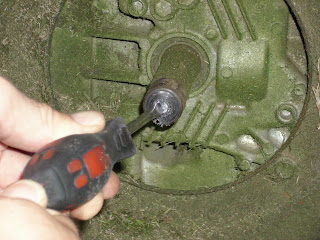The procedure for replacing a broken bolt is straightforward in principle, but it can be a little tricky in practice. First, extract the part of the bolt that is lodged in the shaft (or whatever it's lodged in). Next, find a suitable replacement. Finally, reassemble whatever it is that the bolt held together.
The first step is the tricky part. There's almost never enough of a broken bolt left protruding so that you can turn it with the usual tools. My preferred method in this case is to drill a hole in the center of the bolt, then drill out to both sides and extract it with a flat screwdriver. This method worked well for me in this case.
When drilling metal, it's important to have the right drill bit. There are two major types suitable for drilling through steel: cobalt and titanium. In my experience, the cobalt bits tend to work much better. This may be because I bought a set of cheap titanium coated bits from an auto parts store, but I buy individual DeWalt brand cobalt bits. Both are made of high-speed steel (HSS), but cobalt bits are so named because the steel used to make the bits has a higher cobalt content, whereas the titanium bits have a titanium coating over regular HSS. This means that the cobalt bits can be sharpened, and they are more resistant to high temperatures as there is no coating to wear off.
Regardless of your drill bit choice, there is a proper method for drilling metal to get proper penetration without overheating the bit. The trick is to 'pulse' the drill, applying constant pressure. If you do it right, you will probably get a few long, twisted strings of metal out of the material you're drilling.
Chances are your bolt didn't snap off cleanly and there's some odd slope to the surface that's left behind. Start off in the middle of the bolt, and drill perpendicular to the surface to start out. Once you have an indentation that will keep the bit from 'walking', straighten out and drill straight into the bolt. Once you have a good primary hole, drill at a steep angle to one side, then the other. You want to make sure you use a bit that's small enough to keep all of this action away from the very edges. Here's how mine turned out.
It doesn't have to be perfect. It just has to be long enough to fit the blade of your screwdriver and narrow enough that the screwdriver has something to catch on and turn the bolt.
My original plan was to measure the bolt and pick one up at a hardware store, but once I got the whole thing out, I saw the flaw in that plan. Troy-Bilt apparently likes to use weird, double-threaded, proprietary bolts.
Note how the thread closer to the head has a wider spacing than the thread toward the tip. Odds are you won't find that bolt at your ordinary hardware store. So, it looks like I'm done cutting the grass for the day. I had to order a new bolt online. The first site I went to wanted approximately one arm and one leg for shipping, so I tried another. The first site I came across with my part and cheap shipping was repairclinic.com, so I ordered from them. Shipping was still considerably more than the cost of the part itself, but it's at least a fair price, keeping the total under $10.
Repairclinic also guarantees same-day shipping on in-stock merchandise, so it should be on its way later today and arrive early next week, and then I can finish mowing my grass.

















